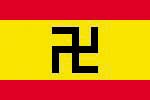

I present this explanation of the Kuna flag so that some readers do not become offended. The Kuna flag has no relation to the nazi symbol; in fact, it was created long before the fascists appropriated this ancient symbol. It appears in the cultures of our Navajo brothers, in Ancient India, in China. For the Vikings it was Thor's Hammer, and of course it is well-known in Kuna culture.
The Kuna flag represents the struggle of the Kuna people to achieve full autonomy and recognition as a sovereign people. The flag was created in the year 1925, based totally on Kuna cosmovision.
The colour red at the top of the flag symbolizes the blood that was spilled during the Spanish invasion which, resulted in genocide for our peoples, ending the lives of millions of human beings on this continent, which we call Abya Yala. The yellow in the centre of the flag represents gold. Kuna cosmovision says that we are people of gold "Olo dule". The red at the bottom of the flag represents the blood that was spilled by our warriors in 1925, during the "Dule Revolution".
The controversial Swastika or "Kaa Nugurya": This symbol represents revolutions emanating from one point and the routes of the four cardinal points, which becomes a cross - also the symbol of a totally stylized human being.
Kuna oral history says: Bab Tummat (the creator) created four men: the first was Machi Kunibipiler. Bab Tummat said to him, "You will travel the route starting at my head (the south) and you will return on the same route." The second was Machi Ologeginyaliler, to whom he also said, "You will travel starting at my feet (the north) and you will return on the same route." To the third, who was Machi Olomegeginyaleler, he said, "You will go from my right hand (the east), and return along the same route." And to the fourth, who was called Machi Olotugnikaliler, he said, "You will explore from my left hand (west), and return along the same route." (cited in Revista Onmaket, Jesus Smith Kantule, pages 10 and 11).
This symbol represents an essential plan in Kuna community life: the Akebandur (Randía Pepeformis), is a cross-shaped vine which also represents the four cardinal points. Bab Tummat recommended to Olokunibipiler to teach human beings to use nature (medicinal plants and others) through ritual songs, in order to defend humanity.
